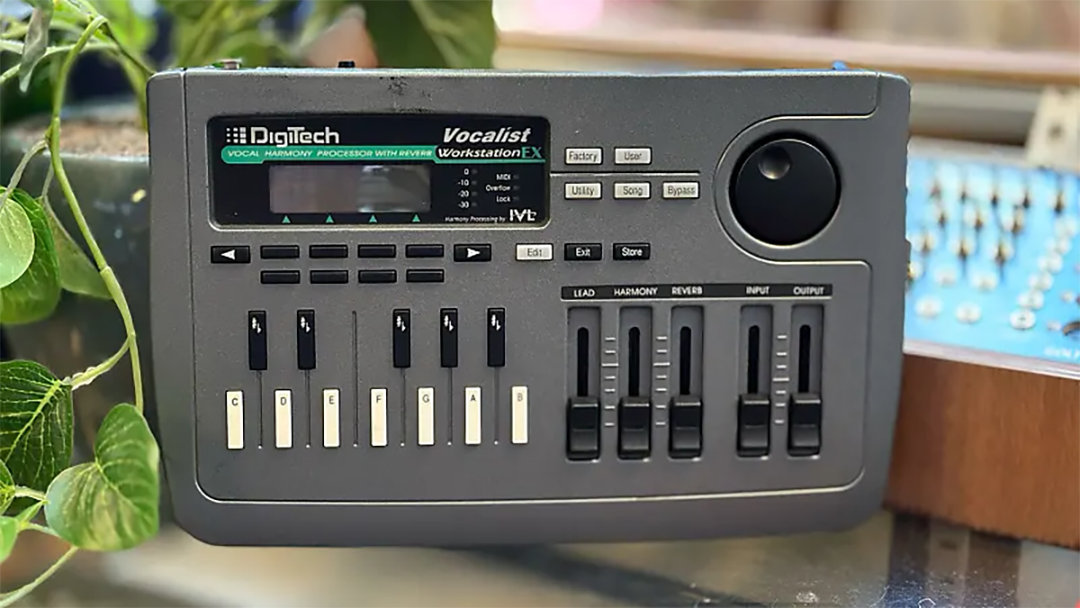“My computer blew up on me, but I didn't want to leave the studio without having done anything that day”: How a crashed PC led to the creation of Hide and Seek, the robotic a cappella that introduced millions to the power of vocal processing
Sparked by a tech malfunction at the end of a late-night studio session, Hide and Seek was featured in hit TV shows and sampled by Jason Derulo, becoming Heap's best-loved song. Two decades on, we recount its unlikely story

From Kraftwerk’s groundbreaking use of the vocoder through to Auto-Tune’s ubiquity in the contemporary charts, vocal processing has come to dominate the sound of popular music over the past five decades.
But among so many examples of vocal transformation, a handful of artists stand tall in their ingenuity, deploying vocal effects in a way that not only brings decorative flair to a song, but defines it completely, creating something that listeners could never have even imagined before the advent of this technology.
Released 20 years ago this month, Imogen Heap’s Hide and Seek was one of the least likely musical successes of the ‘00s. Not only was the song an a capella performance – a format that, though it has its devotees, is rarely seen in the charts – but it was one made stark, strange and all the more moving through the liberal application of vocal processing, rendering Heap’s lovelorn lyrics with harmonies of an artificial, almost alien texture.
Sparked by an off-the-cuff recording at the tail end of a late-night studio session, Hide and Seek became Heap’s best-known song, going on to feature in a hit TV series, selling more than half a million copies and ultimately finding its way into the chorus of a No 1 hit.
Hide and Seek was recorded in 2004 during the sessions for Heap’s second album, Speak for Yourself. Though she had released her debut, I Megaphone, with the backing of a label, Heap chose to go it alone when embarking on her next project, remortgaging her London flat to finance the making of the record. Ambitiously scheduling a mastering session for exactly a year on from the start of the process, Heap set about writing, recording, producing and mixing the project completely independently.
Working from a rented studio equipped with Pro Tools and a modest set-up made up of little more than piano, keyboard, vocal booth and a circuit-bent Speak & Spell, Heap experimented with found sounds and improvised instrumentation, bringing in discarded cardboard tubes to build a DIY organ and assembling an entire track – drums and all – from sounds produced by her piano. But the most unorthodox moment on Speak for Yourself can be found in Hide and Seek, a song that, surprisingly enough, sprung from a computer malfunction.
“My favorite computer blew up on me, but I didn't want to leave the studio without having done anything that day,” Heap told Electronic Musician in 2006. “I was really annoyed with myself, and I’d lost not just that day’s work but two weeks of work. But instead of leaving the studio with a bad feeling, I wanted to do something positive. So I thought: ‘I’m just going to quickly record something, anything, just to clear the air’, and I noticed this bit of equipment that a friend of mine had lent me,” she recalled in a more recent interview.
Want all the hottest music and gear news, reviews, deals, features and more, direct to your inbox? Sign up here.
That bit of equipment was the Digitech Vocalist Workstation EX, a ‘90s vocal effects unit that, alongside Hide and Seek, can be heard on music by Daft Punk and Brian Eno. This digital harmonizer was the more sophisticated cousin of Digitech’s Vocalist Workstation, itself the successor to the Vocalist VHM5, one of the first pieces of kit to give musicians’ the ability to pitch-shift vocals in real-time based on MIDI input.
Bolstered with updated firmware and enhanced DSP, the EX could do that and more, delivering an array of conventional effects alongside its ability to intelligently generate harmonies based on an input signal.
“I saw it on a shelf, plugged it into my little 4-track MiniDisc with my mic and my keyboard and just pressed record. The first thing that I sang was those first few lines: ‘Where are we? What the hell is going on?’” Heap recalled.
“I saw it on a shelf, plugged it into my little 4-track MiniDisc with my mic and my keyboard and just pressed record. The first thing that I sang was those first few lines: ‘Where are we? What the hell is going on?’
Though this initial improvisation was mostly made up of wordless melodies – the song was later re-recorded with lyrics written after the fact – it laid down most of the groundwork for what would become Hide and Seek. “I recorded it in, like, four-and-a-half minutes, and it ended up on the album in exactly the structure of how it came out of me then,” Heap said. “It doesn't feel like my song. It just came out of nowhere, and I'm not questioning that one at all.”
Some have assumed that Hide and Seek’s distinctive vocal effects were produced by a vocoder, but that’s not how Heap created the song’s unearthly harmonies. Vocoders utilize two signals, a carrier and a modulator, analyzing the characteristics of one signal (typically a voice) to filter the other (a synthesizer), giving its synthetic sound a distinctively human quality. Heap’s Digitech box featured a ‘Vocoder’ preset that simulated this effect by pitch-shifting a vocal and manipulating its formants to produce a similarly robotic timbre, without the use of a synth.

The EX’s Vocoder preset layered up to four transposed copies of an input signal, with each layer assigned a pitch via MIDI input – in Heap’s case, the notes played on her MIDI keyboard. This enabled Heap to create the stacked and processed vocals that give the song its sonic identity.
“I set the Vocalist to a four-note polyphony, so even if I play 10 notes on the keyboard, it will only choose four of them. It's quite nicely surprising when it comes back with a strange combination,” Heap explained. “When it gets really high in the second chorus, that's a result of it choosing higher rather than low notes, so I ended up going even higher to compensate, above the chord.”
“Some of the inversions were so beautiful, because of this machine doing its own version of my chords”
Once the bones of the song were laid down, Heap realized that if she was to re-record the song with newly-written lyrics, she would need to painstakingly figure out the four-part harmonies that the EX had randomly plucked from her keyboard playing during the original recording. “I couldn’t record the MIDI, so I had to figure out all the notes,” she recalls. “Some of the inversions were so beautiful, because of this machine doing its own version of my chords.”
Over a three-week period, Heap recreated the harmonies from her original demo, re-recording the song with fresh lyrics and spending long evenings adding subtle details in the production. “It’s just a voice, and there’s no real stuff going on,” Heap explained.
“So I took a long time on the delays, and I spent a lot of time building air around it, because it’s all done inside the box.” Heap copied and pasted many of the breath sounds from the original recording into the final version: “There was something special about it, the sentiment and emotion in the breath,” she adds.
The final touches came in the form of several field recordings, some of which are layered in so quietly as to be almost unnoticeable. The ethereal atmospherics that finish the song are another excerpt from Heap’s original demo with a surprising origin.
“My studio was next to a train line, and right at the end of the recording this train passed by,” Heap said. “So at the end of the song, you hear a train harmonized.” Elsewhere in the track, Heap embedded another deceptive environmental sound: “The sound of the cooking of a meal is quietly frying in the background; it sounds like rain, but it’s actually our dinner.”

Released in 2005, Hide and Seek didn’t gain global recognition until it was featured in a pivotal episode of teen drama The O.C., introducing the song to an international audience that were instantly enchanted by its unnatural beauty. A few years later, Jason Derulo would sample the track’s bridge in the chart-topping Whatcha Say, exposing Heap’s music to millions more listeners in a rare marriage of leftfield experimentation and mainstream pop.
Though its foregrounded vocal manipulation wasn’t entirely novel – Laurie Anderson had built a song around her vocoded voice on the groundbreaking O Superman decades prior – there’s no doubt that Hide and Seek opened the floodgates for the widespread use of creative vocal processing in popular music, inspiring artists like Bon Iver, Frank Ocean, and Jacob Collier to make magic with similar techniques. Not bad going for a song that Heap almost didn’t release.
“People would come into the studio and say that something was missing”
“I remember making the song in the studio and thinking 'God, this is so self indulgent; no one is ever going to like this song', but I really loved it,” Heap recalled. “People would come into the studio and say that something was missing, but I sent it to my friend Frank and he said it was genius and the most amazing thing he had ever heard. I was like, 'Oh that's good, somebody likes it’.” Little did Heap know that the song would set her on the path to worldwide, Grammy-winning success as a musician, producer and pioneer of music technology.
Hide and Seek has recently been remastered for its 20th anniversary, but Heap is not one to spend any time looking backwards. A relentlessly boundary-pushing artist, she has spent those twenty years shaping the future of studio innovation, from gesture-controlled MIDI gloves through to AI-powered vocal models.
Meanwhile, Hide and Seek has remained as relevant as it was upon release; just a few years ago, the song was introduced to a new generation after landing another feature in a hit drama, this time in the BBC’s Normal People. “I’m just so happy for it,” Heap told Metro in 2020. “It’s had this unimaginable, crazy life, that song.”


I'm MusicRadar's Tech Editor, working across everything from product news and gear-focused features to artist interviews and tech tutorials. I love electronic music and I'm perpetually fascinated by the tools we use to make it.
You must confirm your public display name before commenting
Please logout and then login again, you will then be prompted to enter your display name.

